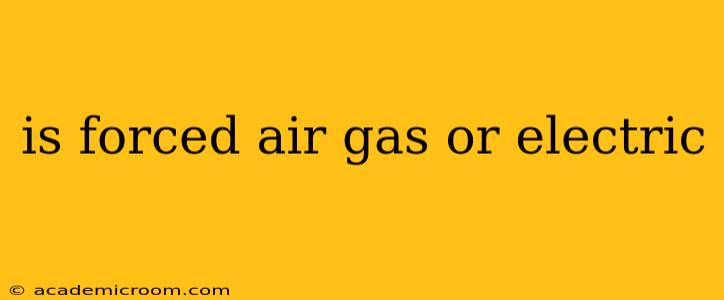Is Forced Air Heating Gas or Electric? The Truth About Your Home's System
The simple answer is: forced air heating systems can be either gas or electric. The core principle remains the same – a furnace (or heat pump in some electric systems) heats air, which is then circulated throughout your home via a network of ducts. However, the method of heating that air is where the difference lies. Let's delve into the specifics of gas and electric forced air systems.
What is a Gas Forced Air System?
A gas forced air system uses natural gas (or propane) as its fuel source. The furnace contains a burner that ignites the gas, heating a heat exchanger. Air is blown across this heat exchanger, picking up the heat before being distributed throughout your home via the ductwork. These systems are often favored for their efficiency and ability to generate significant heat, particularly in colder climates.
What is an Electric Forced Air System?
Electric forced air systems use electricity to generate heat. Instead of a gas burner, they utilize electric heating elements, often coils or other resistive elements, to heat the air. This heated air is then distributed through the same ductwork system as a gas-powered system. While convenient, electric systems can be more expensive to operate, especially in areas with higher electricity costs. Heat pumps, a type of electric forced air system, offer higher efficiency, as they move heat rather than generate it, but these are often more expensive to install initially.
What are the Pros and Cons of Each?
Let's break down the advantages and disadvantages of each type of forced air system:
Gas Forced Air:
Pros:
- Generally more efficient and cost-effective: Especially in areas with low electricity prices and readily available natural gas.
- Higher heat output: Capable of generating significant heat quickly, making them suitable for colder climates.
- Lower initial installation cost (often): The equipment itself might be less expensive than a high-end heat pump system.
Cons:
- Reliance on natural gas supply: Susceptible to price fluctuations and potential supply disruptions.
- Requires venting: Gas furnaces need proper venting to safely exhaust combustion byproducts.
- Potential for carbon monoxide risks: Improper ventilation can lead to dangerous CO buildup.
Electric Forced Air:
Pros:
- No combustion byproducts: Cleaner and safer, eliminating the risk of carbon monoxide poisoning.
- Easier installation in some cases: Often requires less complex venting and installation.
- Can be quieter than gas furnaces: Electric heating elements generally produce less noise.
Cons:
- Higher operating costs: Electricity is typically more expensive than natural gas, leading to higher energy bills.
- Lower efficiency in colder climates: May struggle to keep up with extreme cold temperatures.
- Heat pump systems can be expensive to install: While highly efficient, the initial investment can be significant.
How to Determine Which is Right for Your Home?
The best type of forced air system for your home depends on several factors:
- Your climate: Gas systems tend to be more efficient in colder climates, while electric systems might be more cost-effective in warmer regions.
- Your local energy costs: Compare the price of electricity and natural gas in your area to determine the most economical option.
- Your budget: Consider both the initial installation cost and the long-term operating costs.
- Your home's size and insulation: A larger home or poorly insulated home will require a more powerful heating system.
- Availability of natural gas: If natural gas isn't available to your property, an electric system is your only option.
Ultimately, consulting with a qualified HVAC professional is crucial for determining the ideal forced air heating system for your specific needs and home. They can assess your home's energy requirements and recommend the most efficient and cost-effective solution.
